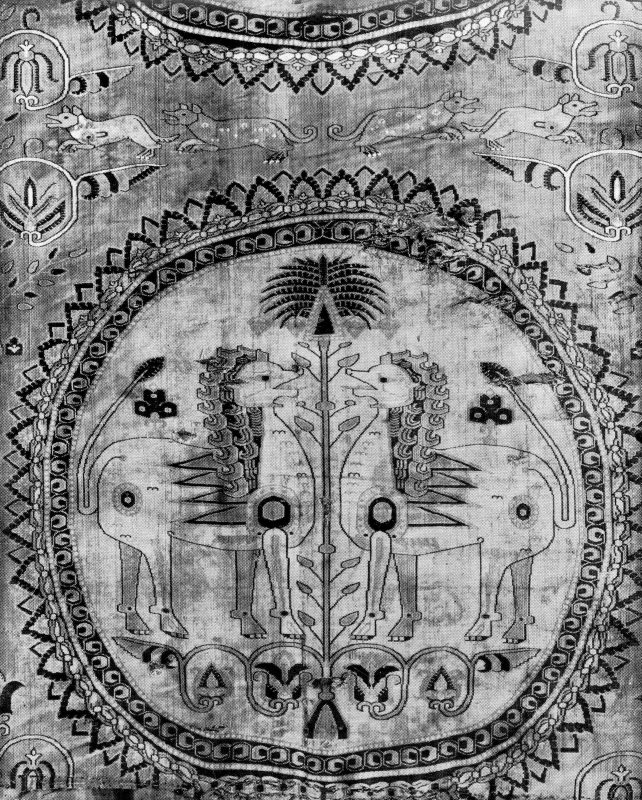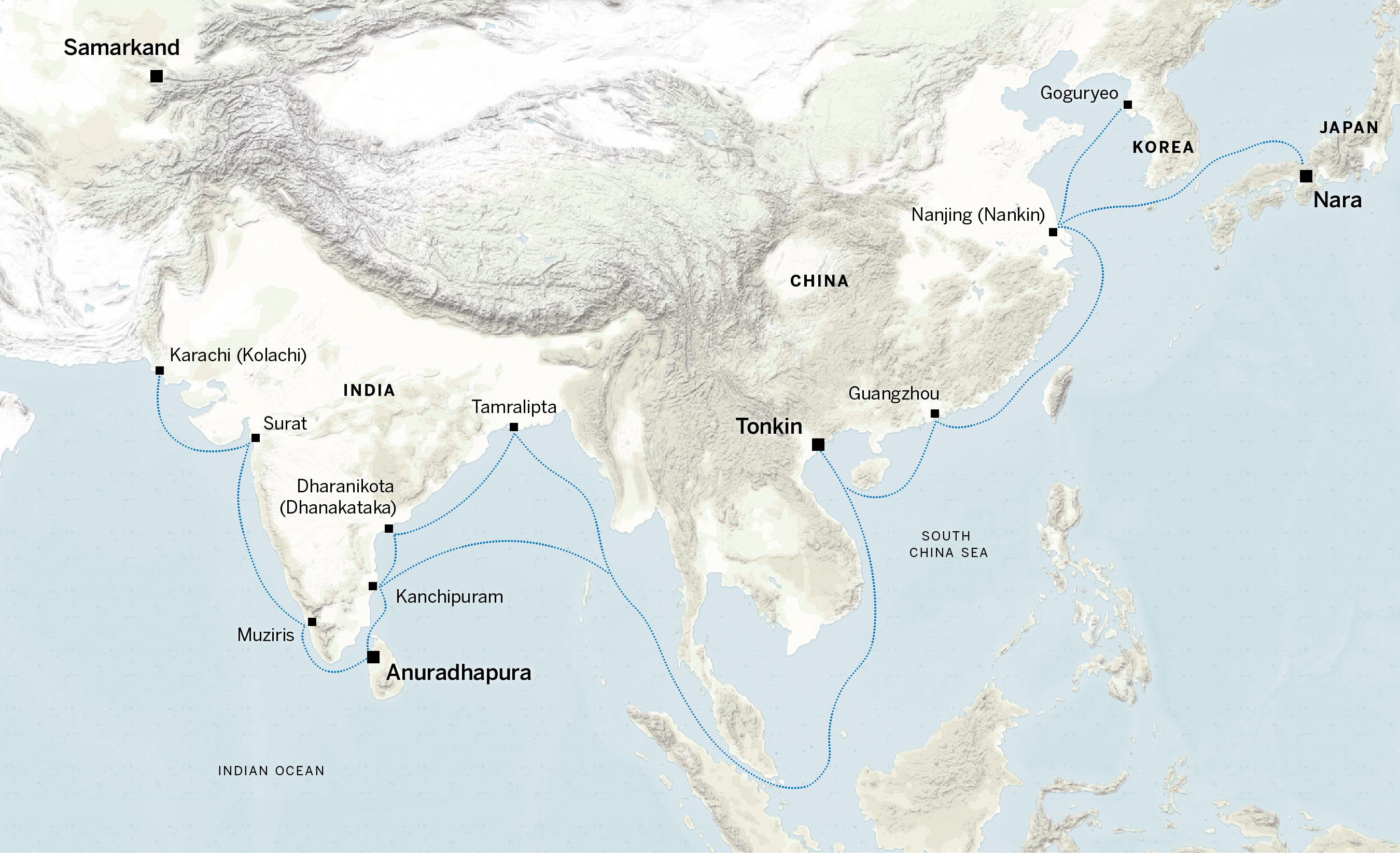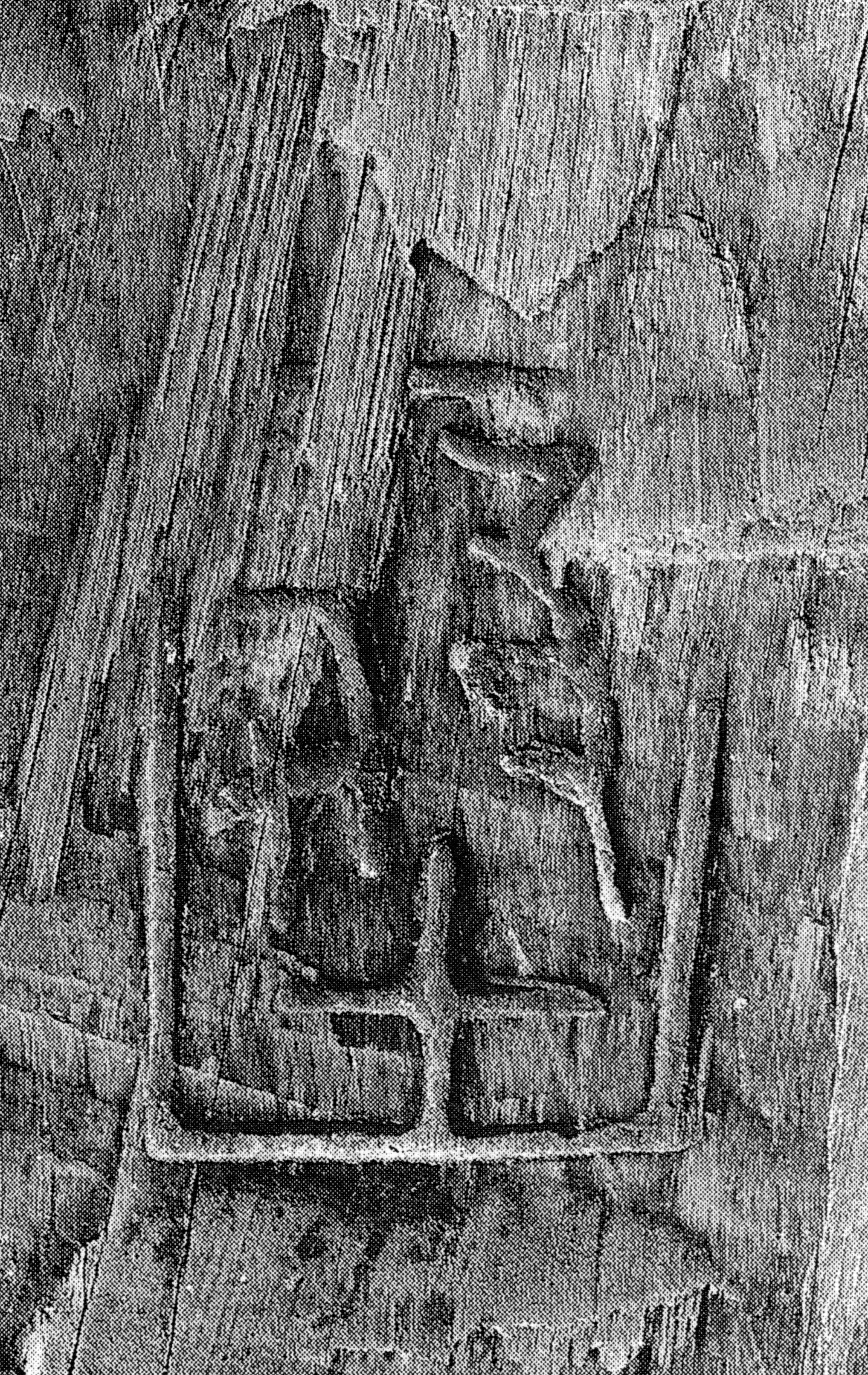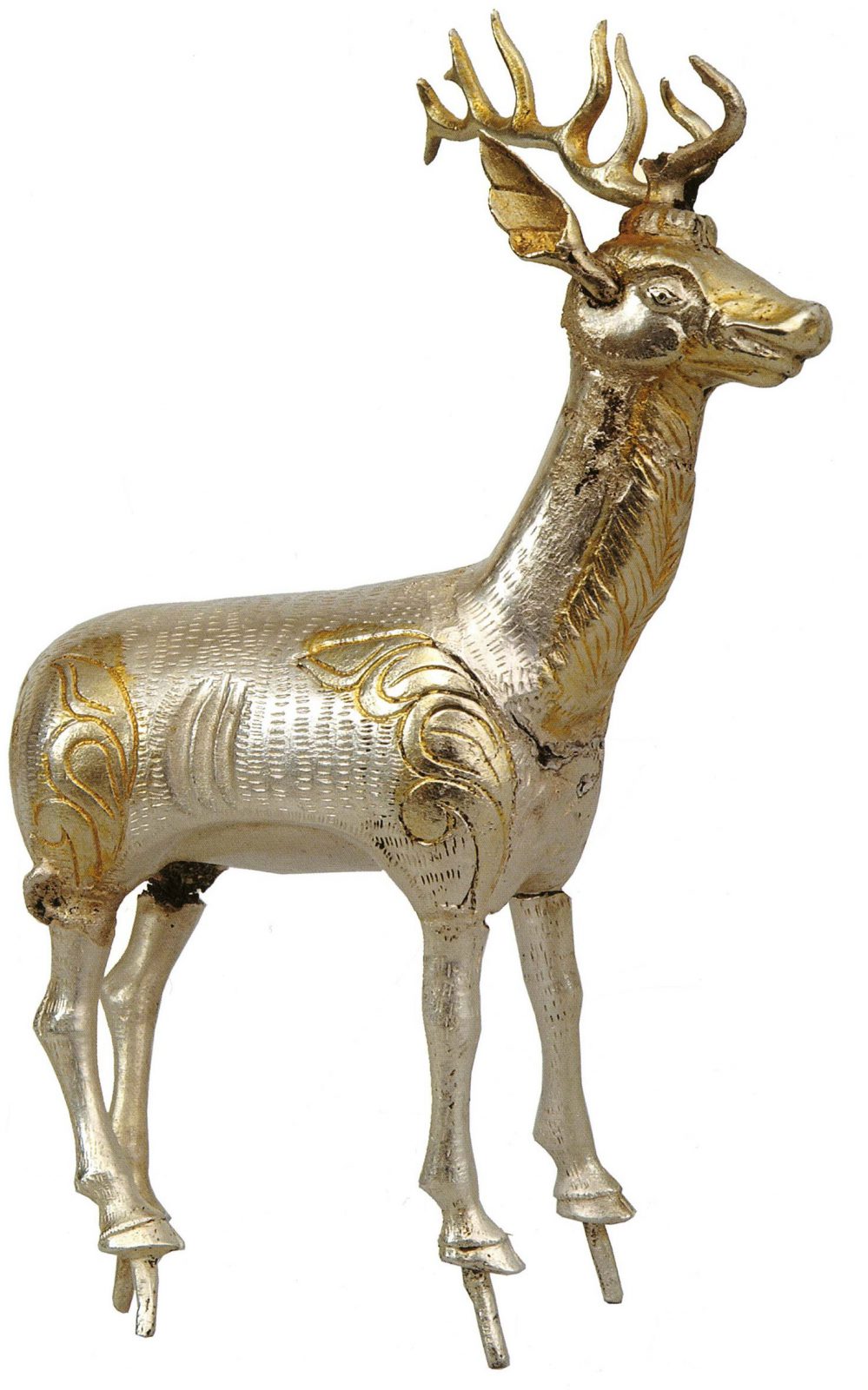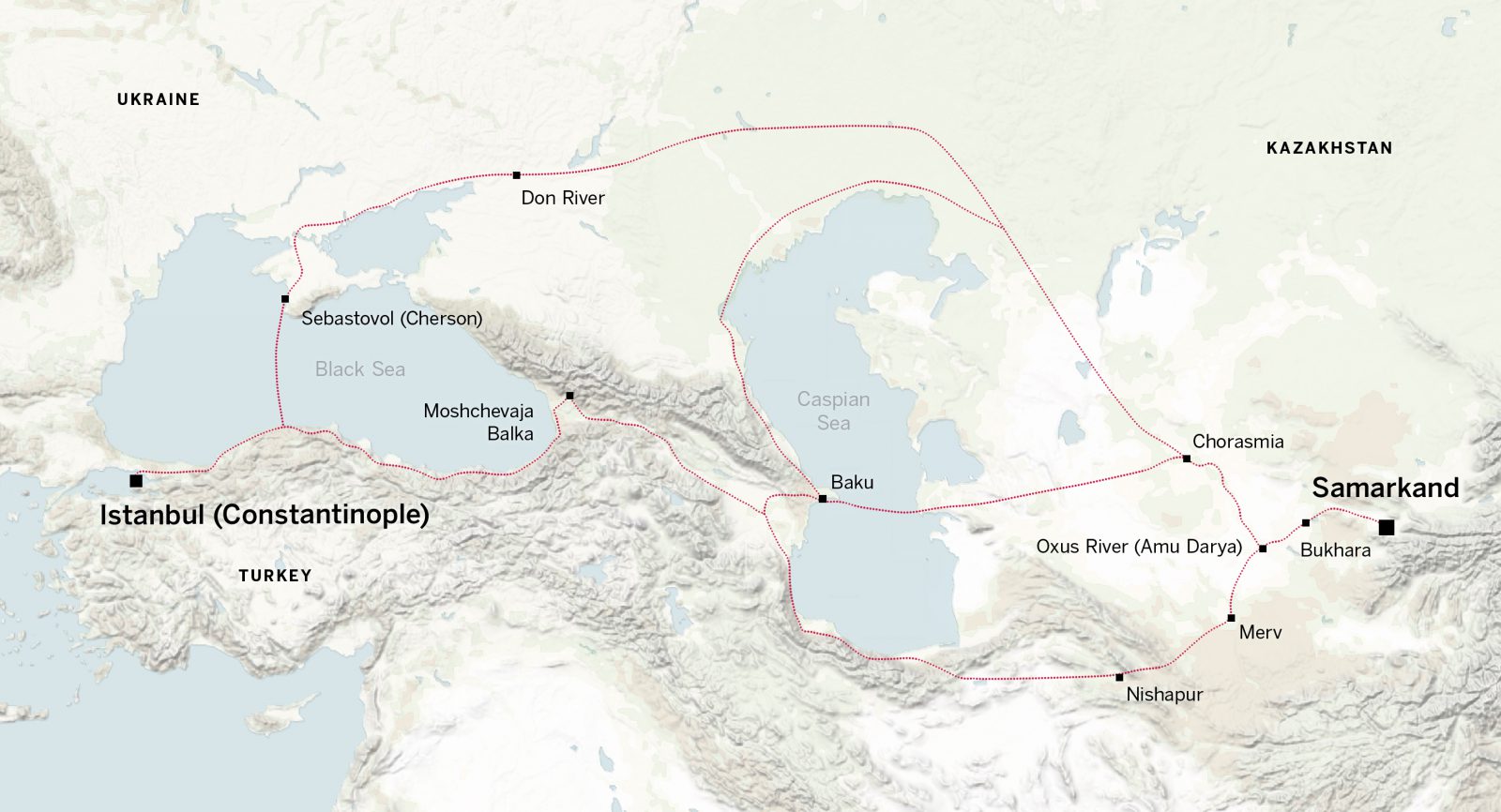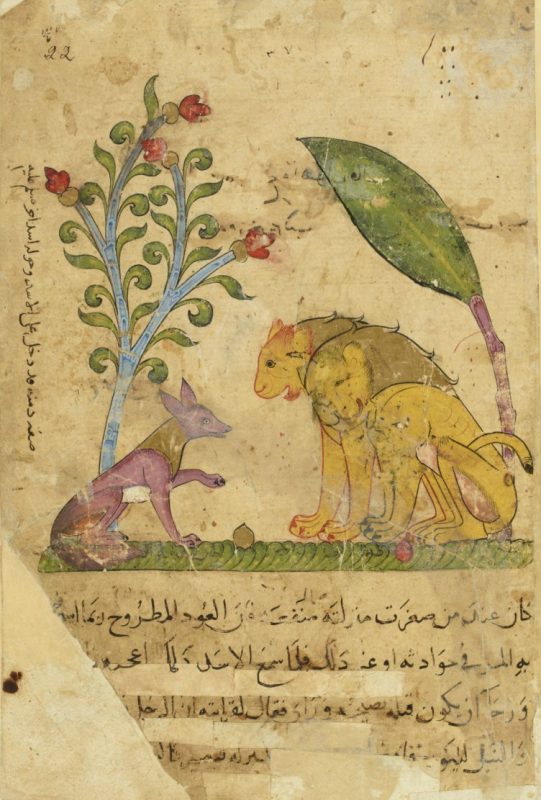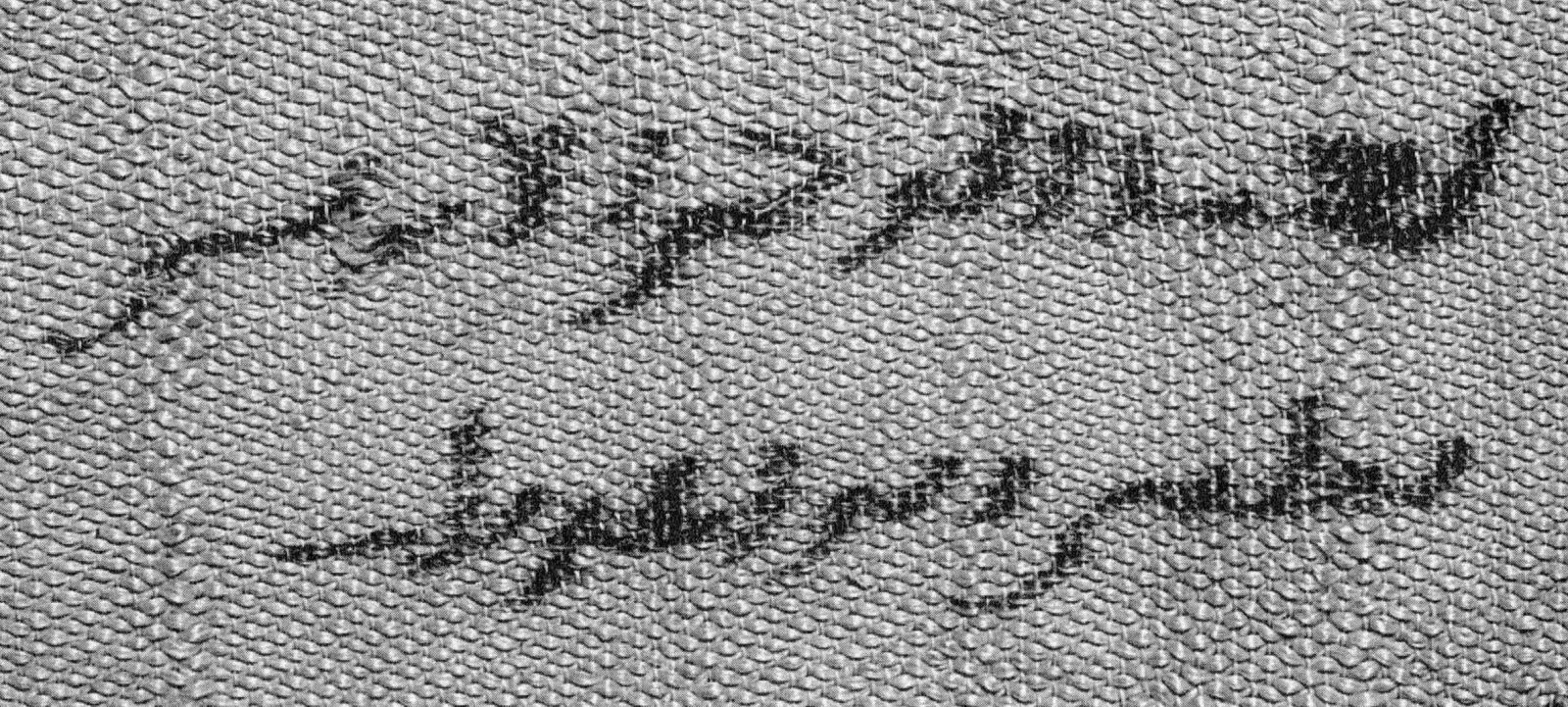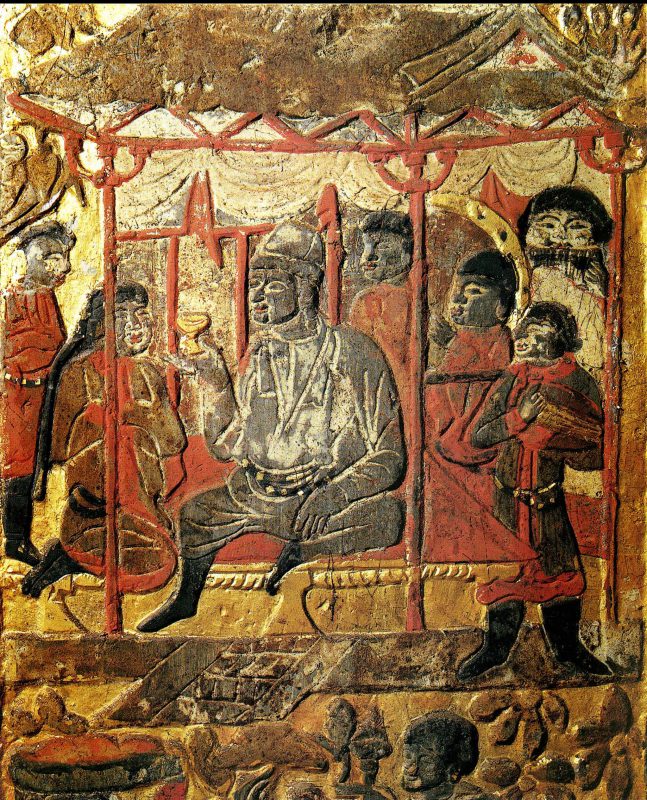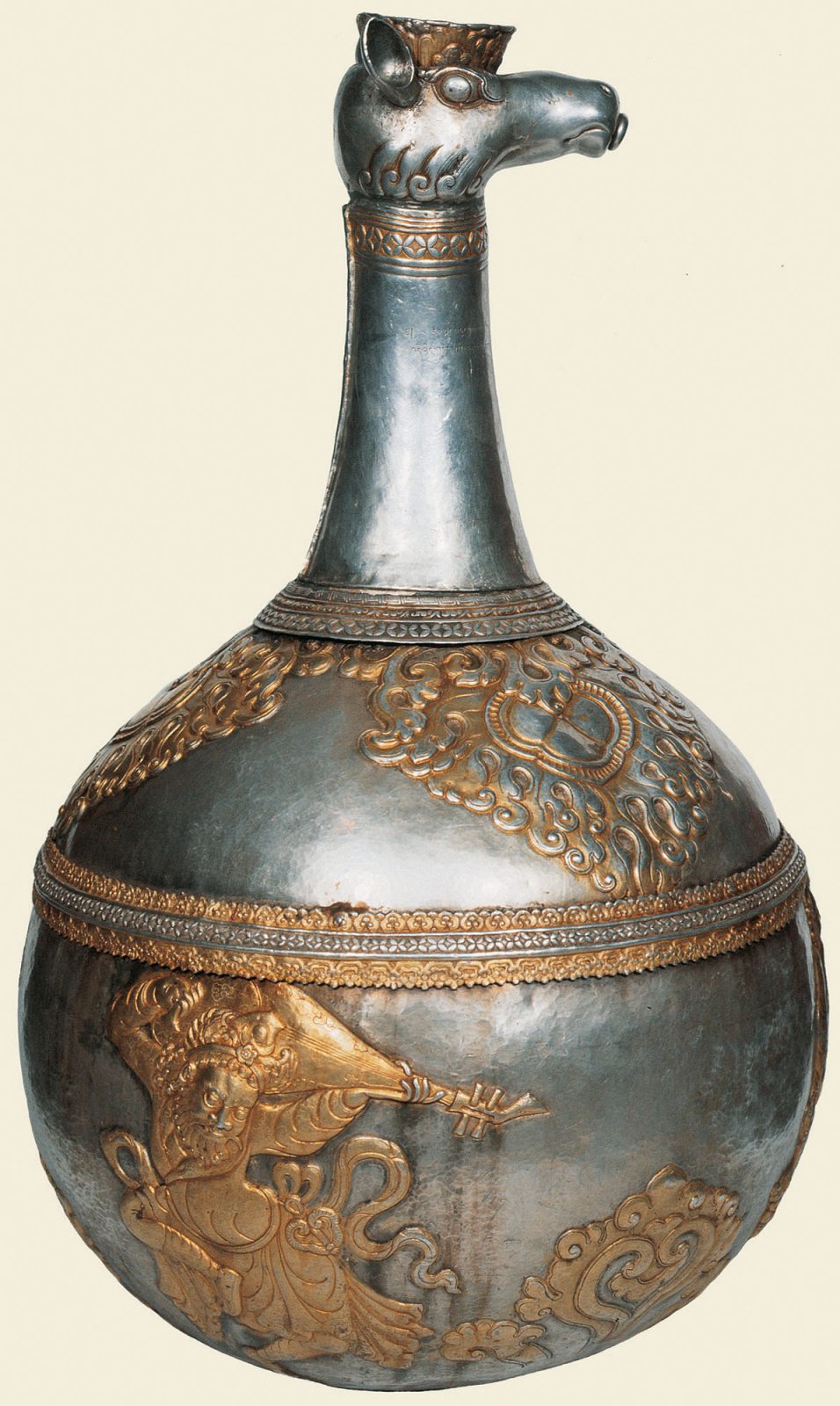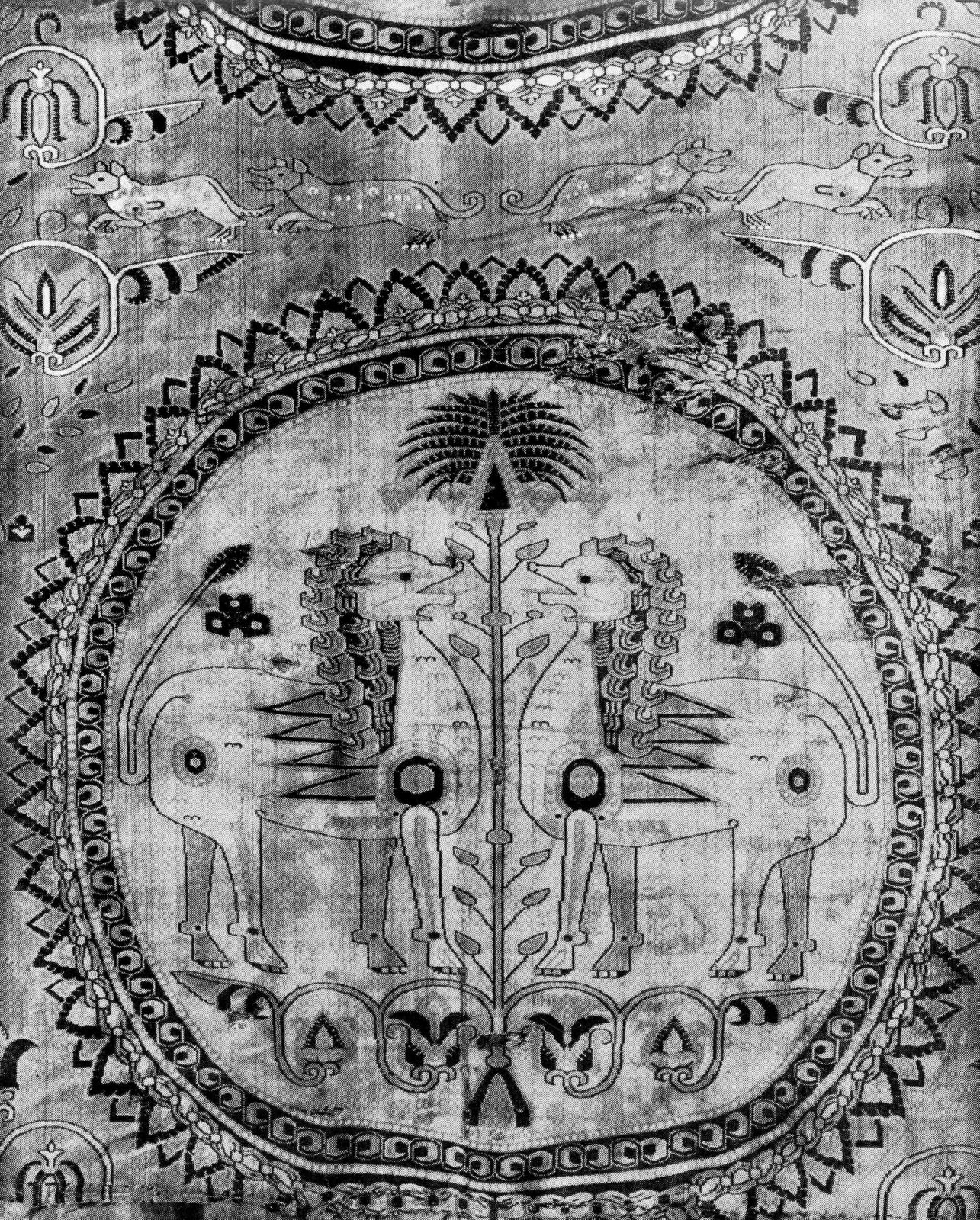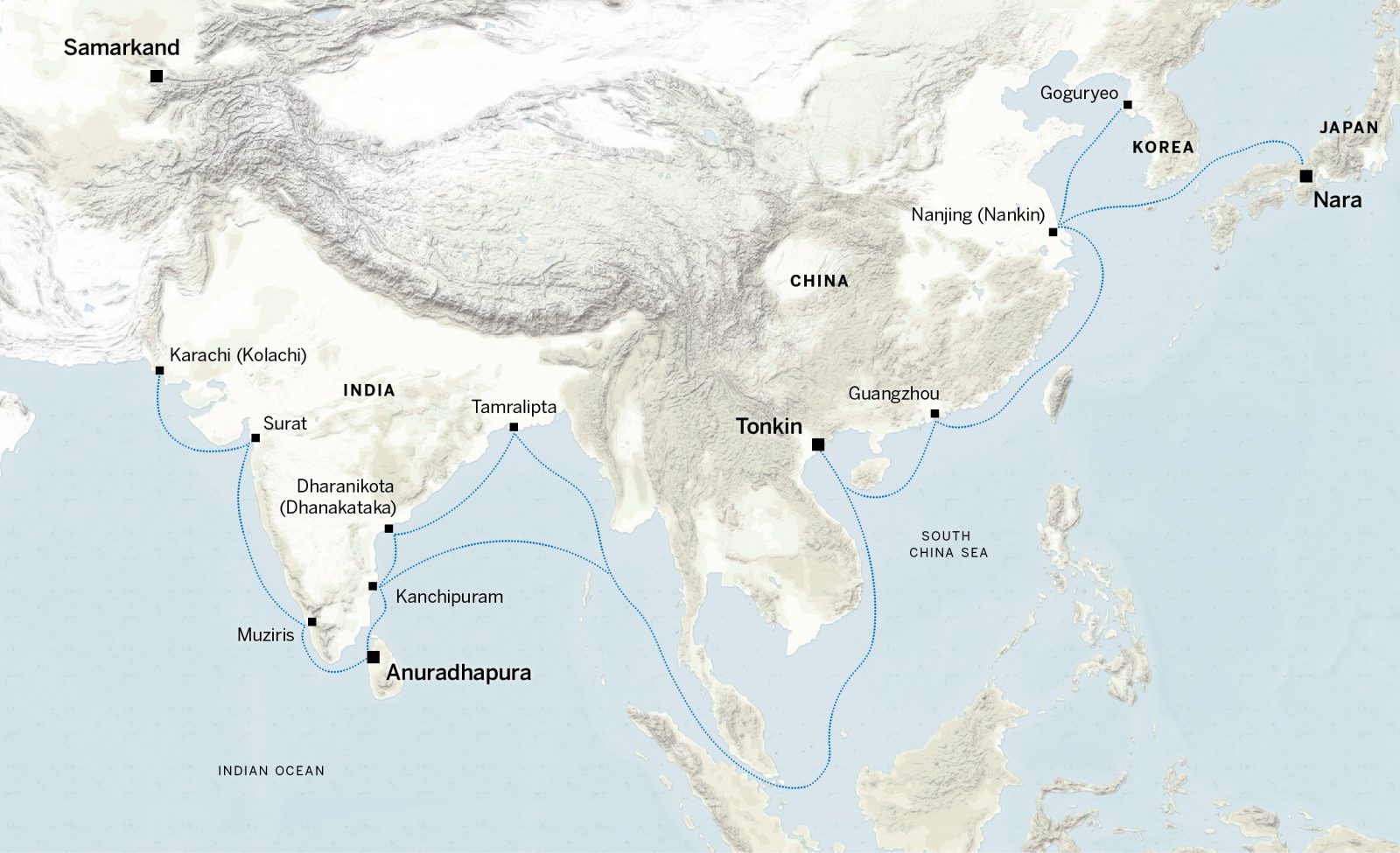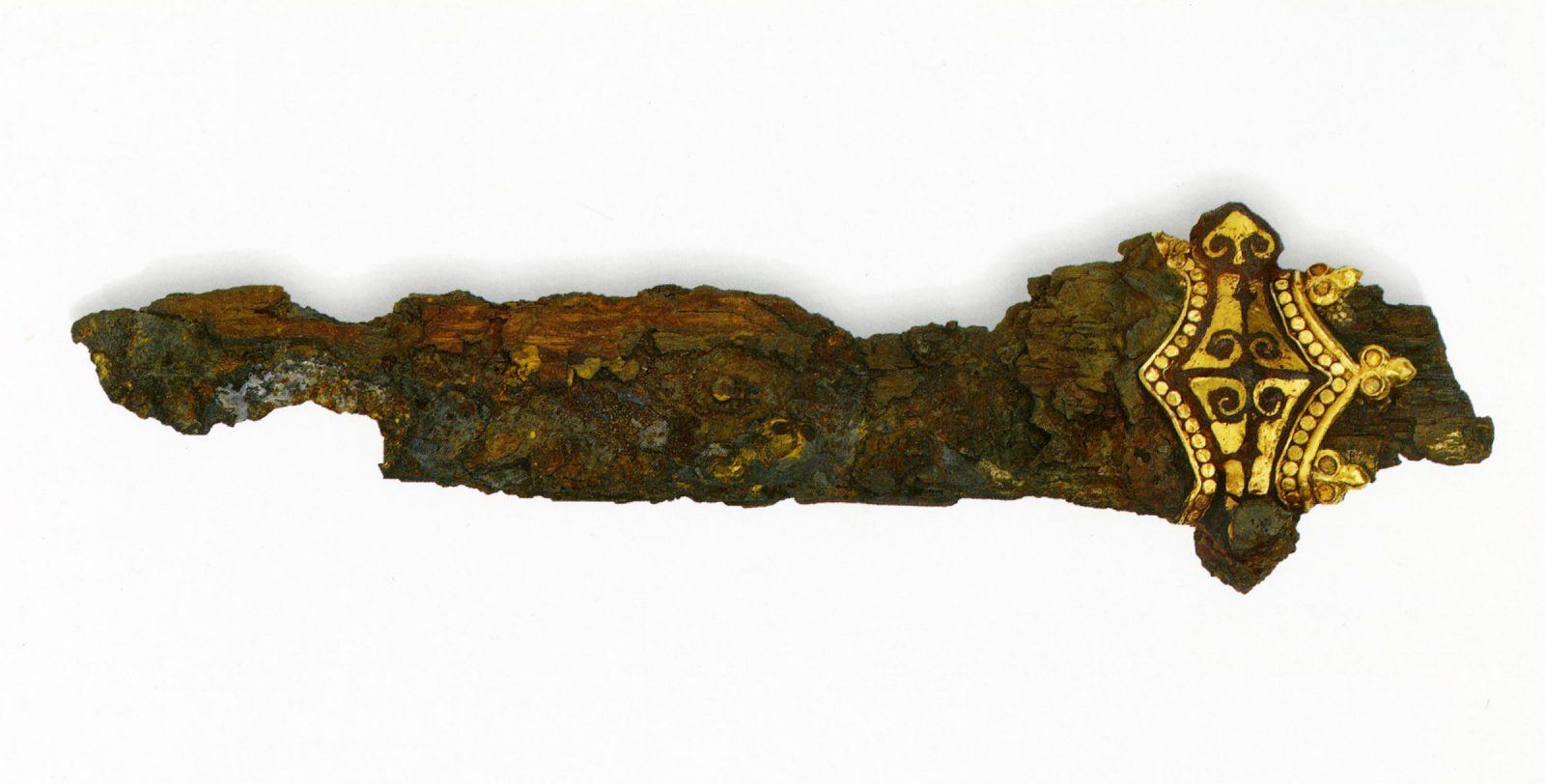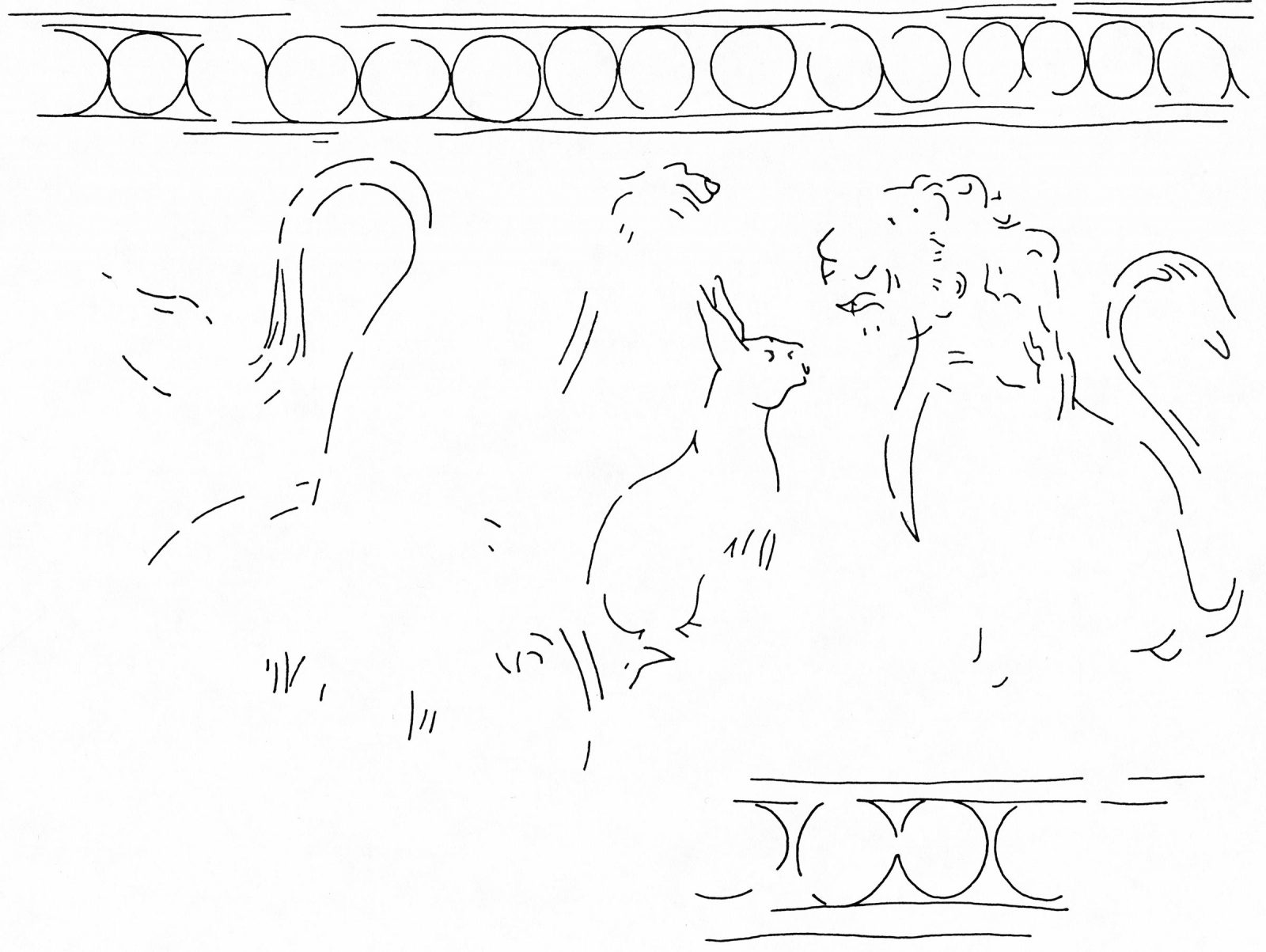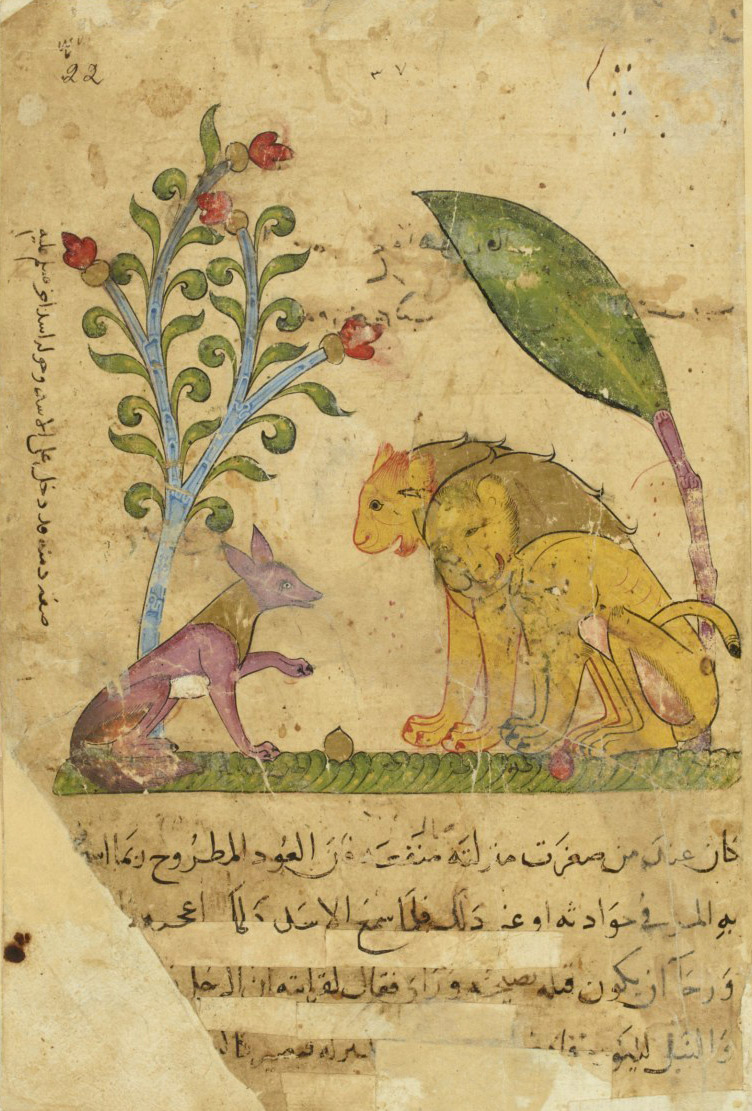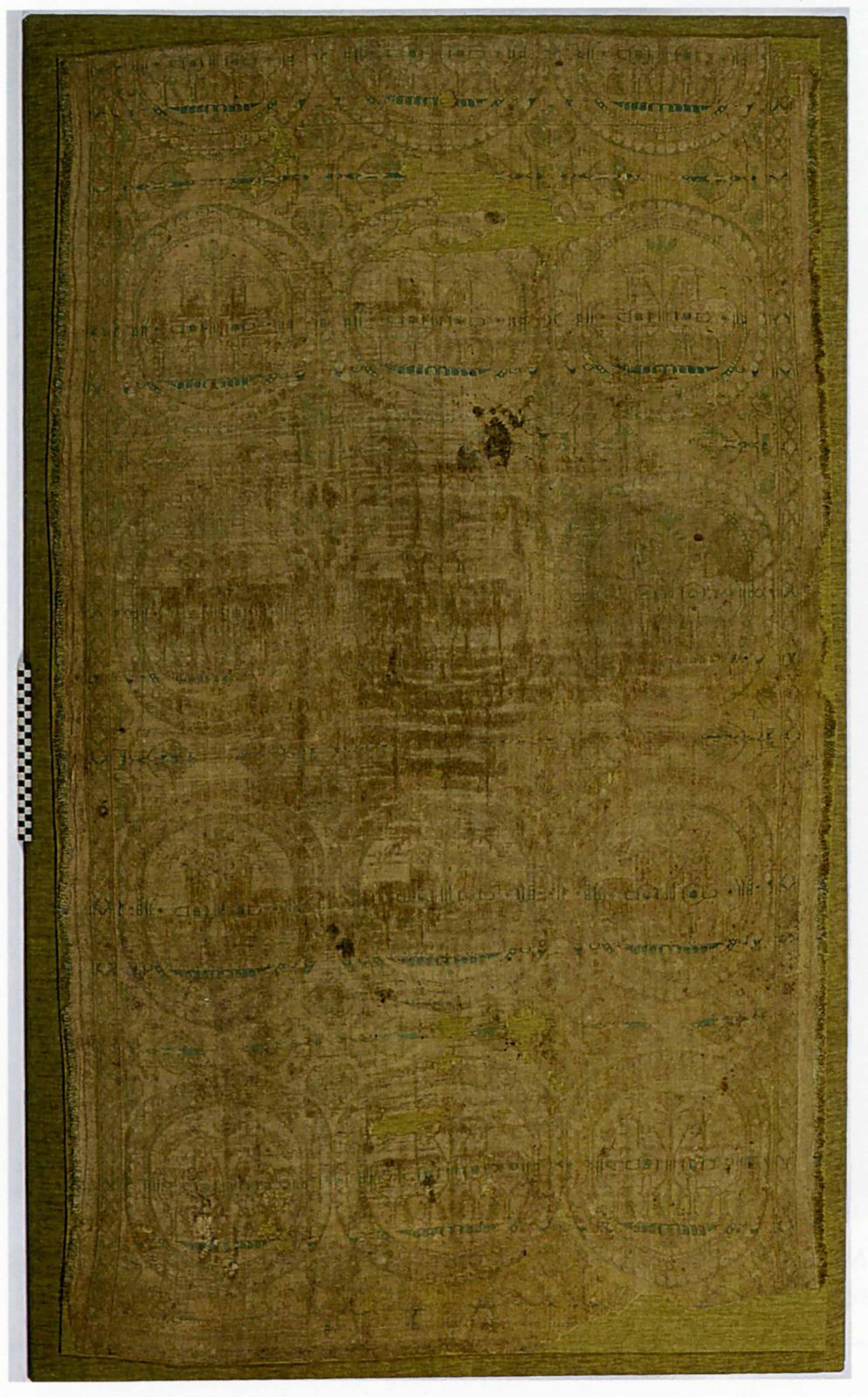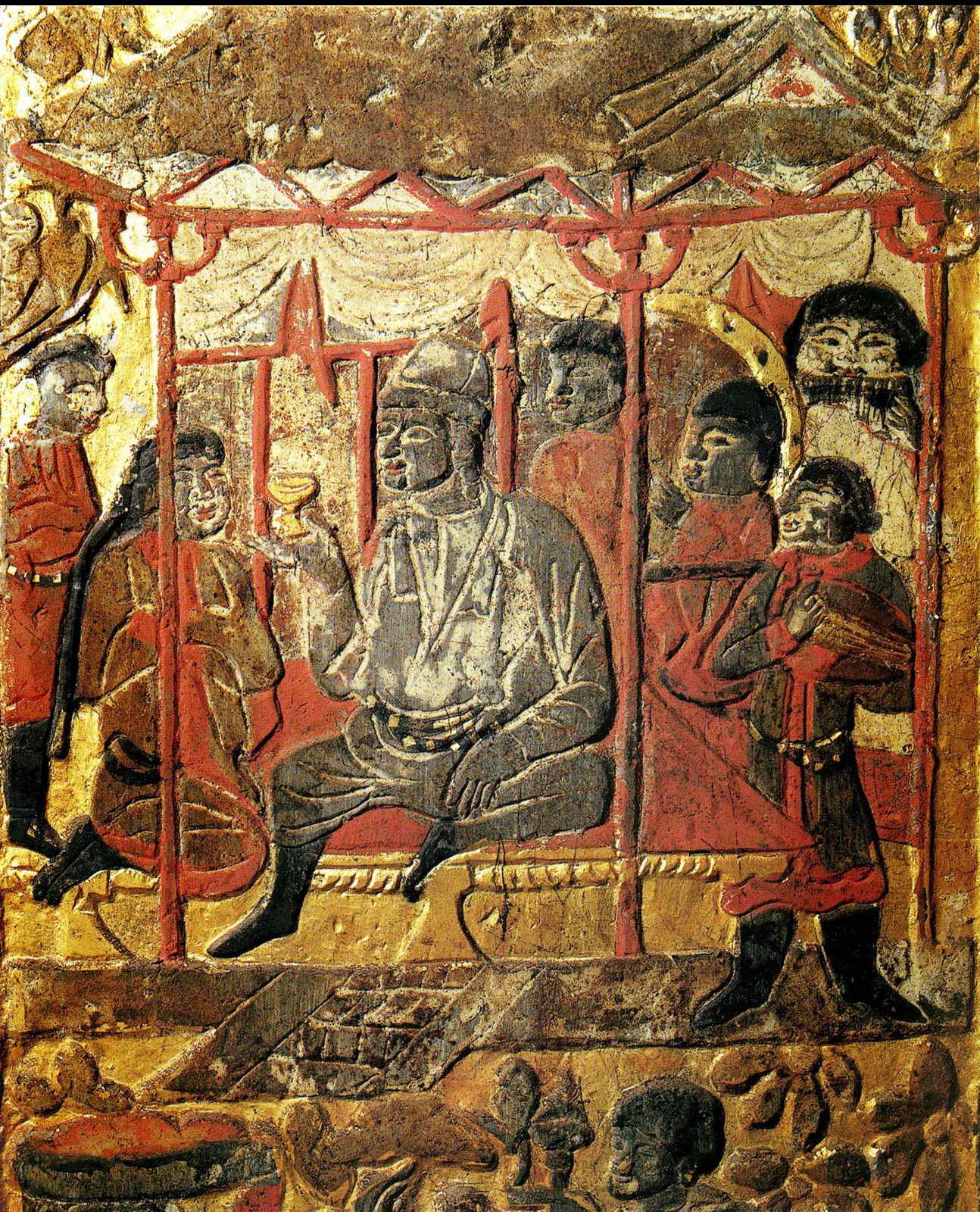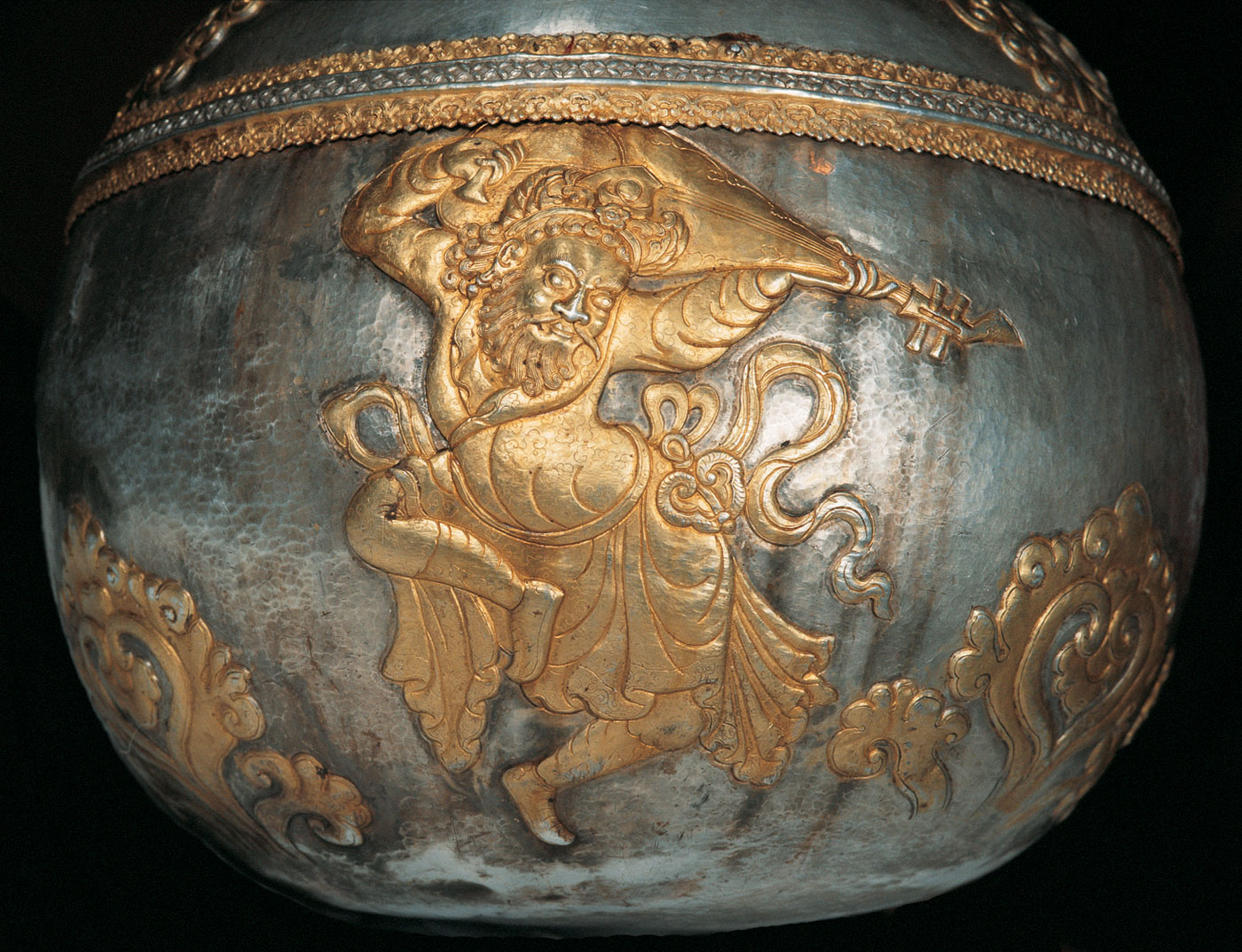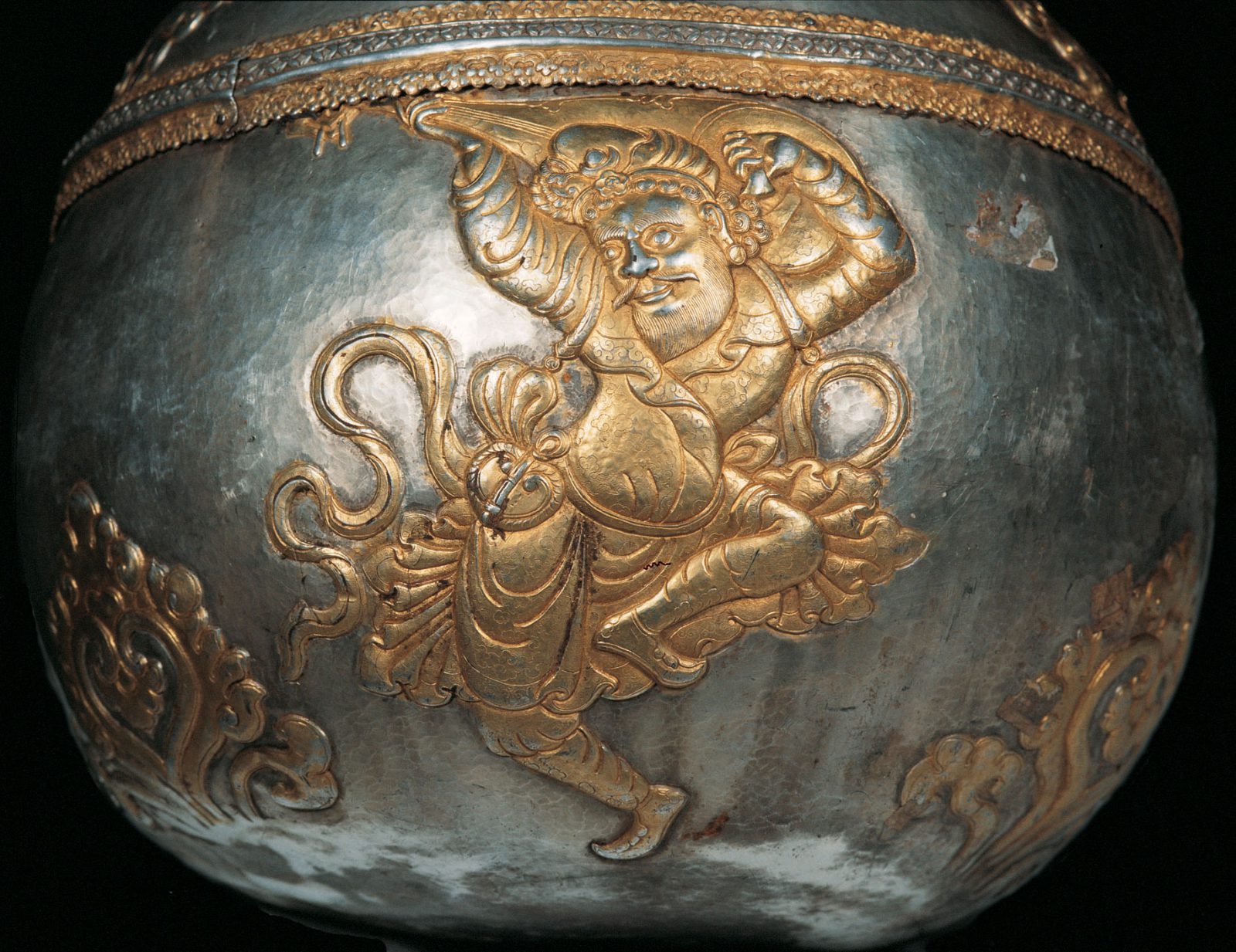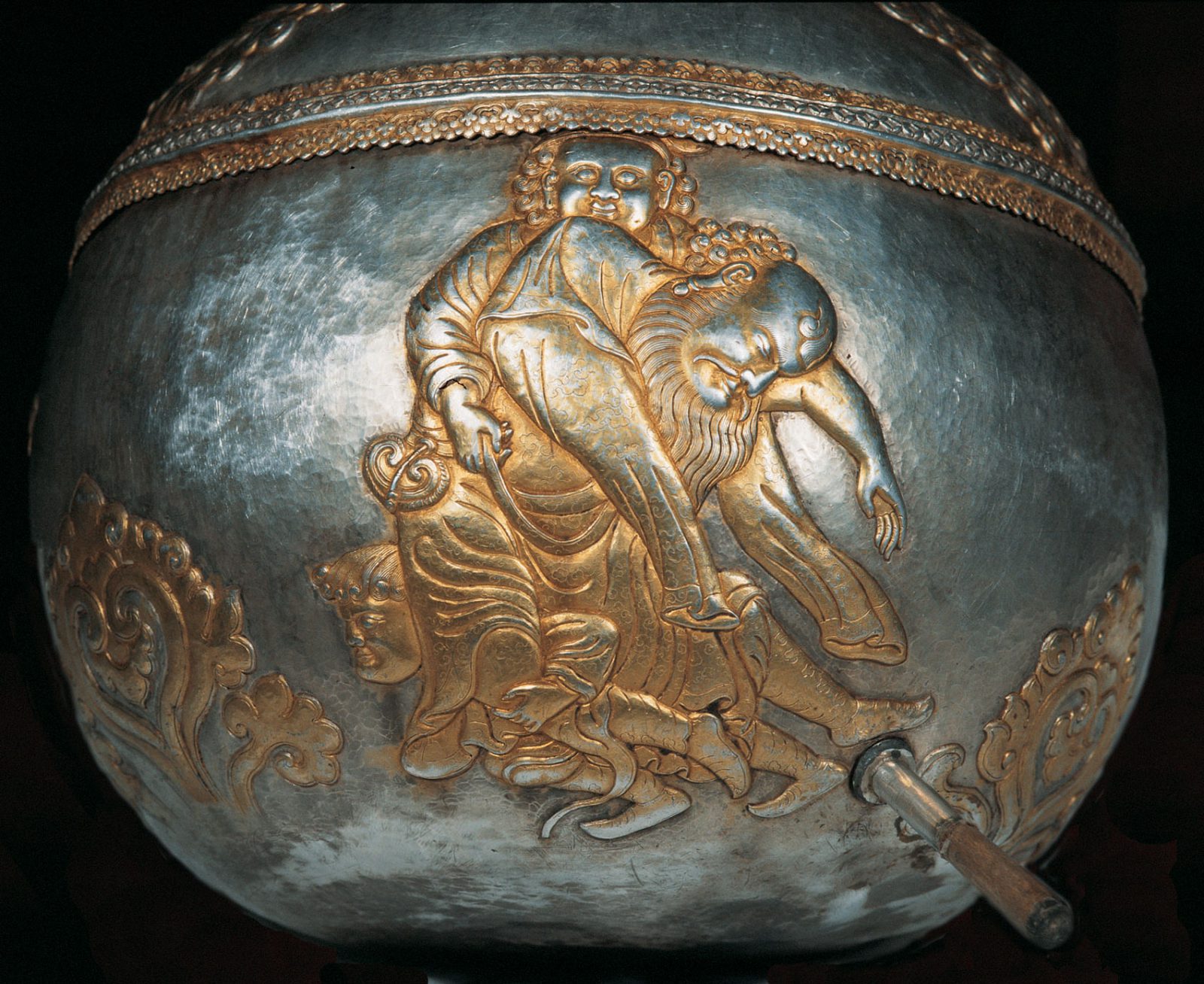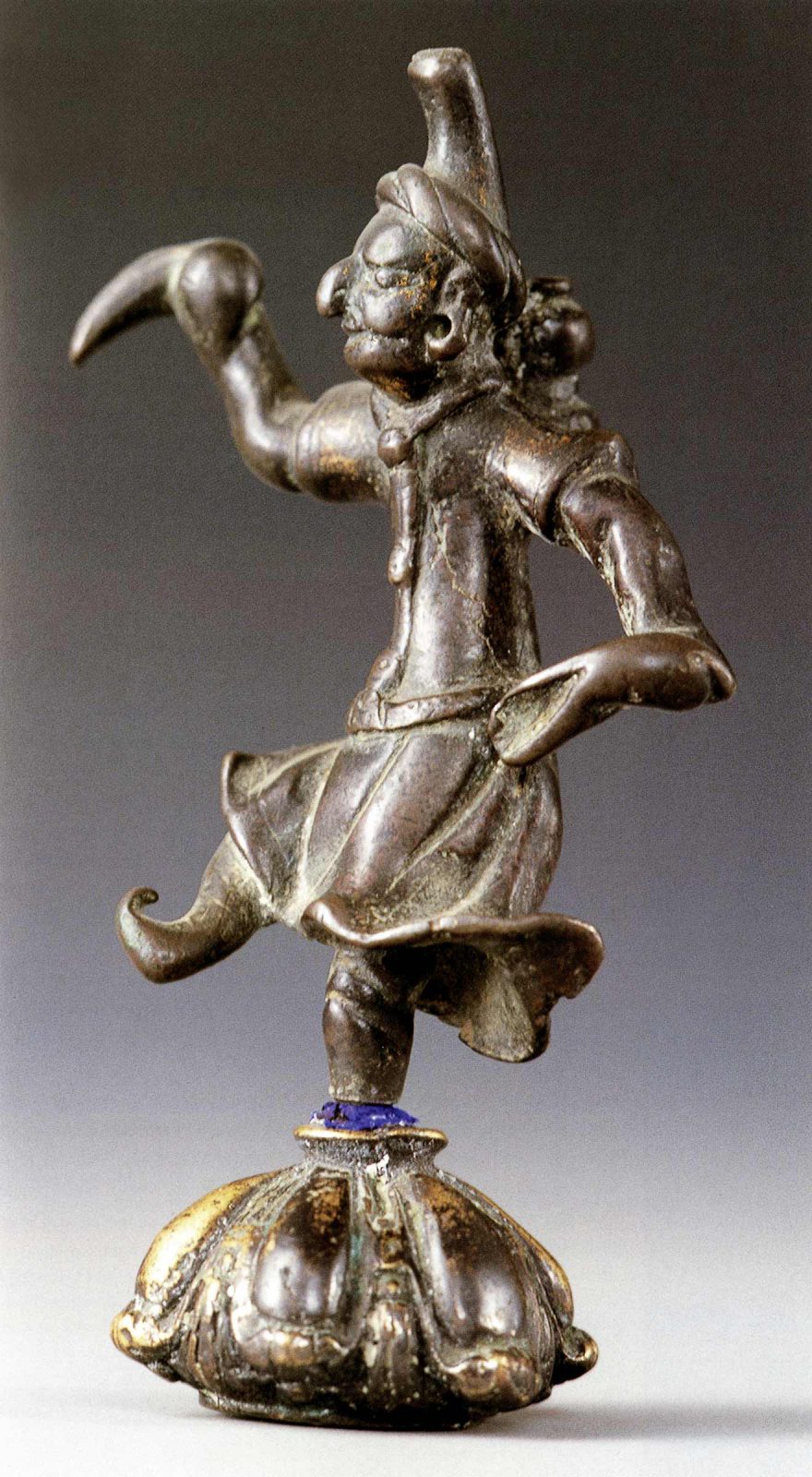From Nara to Nancy
Seeking the Sogdian Abroad
by Julian Raby and Thomas Wide
How far across the world did the Sogdians travel? This essay traces the physical journeys of Sogdian people and objects across Eurasia, as well as the way the influence of the Sogdians was felt in various cultures’ artistic traditions.
He leers drunkenly at us with his close-set eyes and arched eyebrows, absurdly long, drooping nose, and earlobes that stretch low, punctured with gaping holes. He is grotesque, comic, slightly menacing—an ancient clown of the Far East.
We are in Nara , southern Japan. It is the temple of Hōryūji, a treasure house of great importance, where once lay preserved a world of precious objects gathered from across Asia during the 6th to 9th centuries. Here was a Silk Road cabinet of curiosities: instruments, statues, precious woods, textiles.
But we are interested today in a single mask made of Paulownia wood; Fig. 1. For it is believed that this mask may be the farthest sighting east of an elusive character that scholars have been seeking for over a century—the Sogdian abroad.
Fig. 1 Japanese Gigaku mask of “Intoxicated Barbarian King” (Suiko-ō). Japan, 8th century. Carved Paulownia wood, with white undercoating, polychrome pigments, gold leaf, and ink drawing; adhered horse hair; 37.0 × 22.6 × 29.4 cm. Shōsō-in, Nara. Treasure No. 47. View object page
Photograph © Shosoin Repository.
Now we are four thousand miles away, on the other side of the world in Nancy , northeastern France. Here is a scrap of textile—its rich blues and oranges long since faded—with two stiff lions flanking a palm tree, encircled in a medallion; Fig. 2. Some claim that this delicate fragment, used to wrap the relics of a European saint, is Sogdian in origin. Can it be true that at two religious treasuries on opposite sides of the world, France and Japan, each preserves a fragment of Sogdiana—a faded and frozen memento of one of the great lost cultures of Eurasia?
Sogdians and the Silk Road
Ever since the German cartographer and explorer Baron von Richthofen coined the term “Silk Road” (Seidenstraße) in 1877, we have been fueled by dreams of a transcontinental trade route linking Asia and Europe, “East” and “West.” To a certain extent, the idea of the Silk Road is the product of the modern mind, keen to find precedents and a genealogy for our interconnected, “globalized” contemporary world. We delight to find ancient goods that have crossed continents and cultures: an Egyptian glass beaker found buried in a chamber in central Afghanistan, a Central Asian silk in a European cathedral. We revel in the traders and travelers that crossed those continents, collected and shared knowledge, moved between worlds. It comforts us that the ancients were not so different from us after all, or perhaps that we are not so different from the ancients. Such stories provide us tools to elucidate, even justify, the way we live today and the values we hold—the thrill of the exotic that fuels our sense of cosmopolitanism.
The discovery and deciphering of caches of Sogdian documentsMarc Aurel Stein Learn more about explorer and archaeologist Sir M. Aurel Stein at the beginning of the 20th century was a great boon to scholars engaged in this quest. For in the Sogdians we seemed to have found the Silk Road people par excellence: cosmopolitan, well-traveled, mercantile, syncretic in their practices and beliefs. Over the last hundred years, and increasingly in the last thirty years, scholars have attempted to hunt down traces of the Sogdians around the world. They have had spectacular success in Central Asia and China, where the discovery and excavation of multiple sites have uncovered city layouts; religious, administrative, and personal documents; wall paintings; metalwork; ossuaries and stone sarcophagi. These concrete artifacts of Sogdian culture have allowed us to build a picture of Sogdian life across a central tract of the Silk Road. But what of farther afield? Can we find traces of the Sogdians along the entire span of the Silk Road, from Nancy to Nara, Bangkok to Belgium?
This is no easy quest. We are dealing with a culture that never exerted great political power beyond its homeland. Sogdians abroad were largely a class of merchants, craftsmen, and entertainers. These are the kinds of people who do not write histories and do not have histories written about them. With one or two notable exceptions, they are nameless. In historiographical terms, we would consider them “subalterns”—subordinate people of lower social position rather than the usual “great men”—kings, generals, sages—who dominate history. Any attempt to trace the extent of the Sogdians’ global reach must thus rely on stitching together the brief references to them found scattered through foreign chronicles, analyzing material evidence from across Eurasia for signs that an object may have been Sogdian in origin, and searching for the representation of Sogdian figures in artworks made by other hands.
Such a quest is going to be incomplete, tentative, speculative—and exciting. There is something exhilarating about the hunt for a lost people: a kind of rescue history. First, let us start by piecing together the textual and material evidence for Sogdians and their culture beyond Central Asia and China, in order to understand the potential extent of their trade and influence. Second, we will consider the representations of Sogdians in foreign artworks to gauge how far they spread, if not in physical presence, at least in image and reputation.
The Textual and Material Evidence of Sogdians Abroad

Fig. 3 Sogdian rock inscriptions. Shatial, Pakistan, 3rd–7th century CE.
Photograph after Nicholas Sims-Williams, Sogdian and Other Iranian Inscriptions of the Upper Indus, Section II.I, Plate 10b (1989) of Vol. III, Sogdian, in Part II, Inscriptions of the Seleucid and Parthian Periods and of Eastern Iran and Central Asia, of Corpus Inscriptionum Iranicarum (London: School of Oriental and African Studies [SOAS]).
In analyzing the textual and material evidence, we would be wise to start close to the Sogdian homelands in Sogdiana and western China, where we are on surer ground, and slowly work outward. Starting with India, to Sogdiana’s southeast, we certainly have enough evidence to conclude that Sogdians were active traders and travelers between their homelands and India, as well as between India and China. Our best evidence for this is the inscriptions carved into rocks found in Shatial, in the passes of the High Indus in northern Pakistan; Figs. 3.
These inscriptions were uncovered following the building of the Karakorum Highway in the 1960s and 1970s, which made previously inaccessible areas of Pakistan reachable for archaeologists. Such evidence even suggests that the Sogdians had “an effective monopoly of the trade” within the triangle of Sogdiana, India, and China. Alongside these inscriptions, we also have scattered accounts of Sogdian traders traveling farther into India and settling there. One account from a Chinese source regarding a Sogdian Buddhist monk, whom we shall meet shortly in Vietnam, described him as coming from a family of Sogdians that had spent “many generations” in India.

Fig. 4 Nicholas Sims-Williams (School of Oriental and African Studies) discusses the inscriptions found at Shatial in today’s Pakistan.
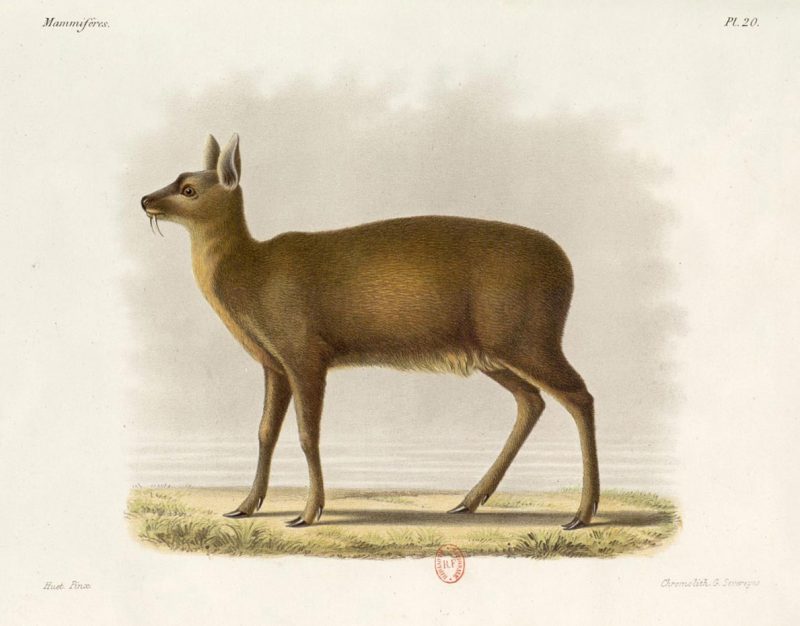
Fig. 5 Tibetan Musk Deer (Moschus chrysogaster). Chromolithograph.
Photograph after H. Milne Edwards, Recherches pour servir à l’histoire naturelle des mammifères: Comprenant des considérations sur la classification de ces animaux (Paris: G. Masson, 1868–74), Plate 20. Online source: gallica.bnf.fr / BnF.
Pushing farther east from northern India, we also catch glimpses of Sogdian traders and craftsmen in Tibet . Their primary reason for being there was musk, a scented substance that a type of Tibetan deer produced that was much prized for making perfume; Fig. 5. We know from ancient Sogdian letters, discovered in 1907 in western China, that Sogdians traded in this musk. Their reputation was such that the 9th-century Arab historian and geographer al-Ya‘qubi describes “the musk of Sughd”’ (i.e., Sogdia) as second only to that of Tibet. Ya‘qubi also notes that “merchants of Khorasan ” (now northeastern Iran and Central Asia) would travel to Tibet to buy musk and then return home, from which they would export it “to various points of the globe.” There is also some evidence for the presence of Sogdian craftsmen in Tibet, where their metalworking skills seem to have been prized. We will review the evidence for this in more detail below.
If we want to continue traveling through South and Southeast Asia, we must now follow a different course: the maritime spice route; Fig. 6. The great scholar of pre-Islamic Central Asia Frantz Grenet has made a strong case for the existence of Sogdian merchants in Vietnam and Sri Lanka. For Vietnam, we have a 5th-century source in the form of a Chinese collection of biographies of Buddhist monks. This collection tells of a 3rd-century monk named Kang Senghui 康僧會, whose family had spent “many generations” in India along with other Sogdians before his father settled the family in Tonkin , in what is now Vietnam. The family name Kang is instructive. It was a name used for those families coming from “Kangju,” which by this time was largely understood to mean the area of, and around, Sogdiana.
For Sri Lanka, our source is a hundred years later, in the 5th century. Here, we have a text by a Chinese pilgrim, Faxian 法顯, which notes that “Sapo” traders could be found in Anuradhapura in Sri Lanka. While Sapo does not conclusively refer to Sogdians, we have another source that supports the claim that Sogdians were living in Sri Lanka: a biography of Amoghavajra, an influential 8th-century teacher of Tantrism in China. This work describes Amoghavajra as being born in Sri Lanka to a North Indian father and a mother from a “Kang family.” As we have already seen, Kang most likely refers to Sogdiana, and these two sources together are strong evidence for Sogdians settling in Sri Lanka.
Having followed textual and material evidence of Sogdians as far east as we can, it is time to retrace our steps and then head north from Sogdiana, up and into the Great Steppe. From Kazakhstan and Xinjiang this immense plain stretches east to Mongolia and Manchuria, and north and west to Russia and the Caucasus. Were the Sogdians able to take advantage of this vast economic and cultural zone to their north?
We can indeed find traces of the Sogdian past in archaeological and written evidence of the 6th to 9th centuries. There the Sogdians emerge as successful middlemen between the Chinese and the nomadic powers to the north of Sogdiana. With the establishment in the mid- to late 6th century of Turk rule over most of the Eurasian steppe, the pace of trade across Eurasia increased. The Sogdians were well placed to capitalize. One key commodity traded between the steppe and Sogdiana was slaves, and we have written evidence that Samarkand was a center of slave trading between the northern steppe and other parts of Central Asia.
Heading north, we know from archaeological excavations of burial sites of nomadic elites living on the steppe that mirrors, textiles, and metalwork imported from Central Asia were valued items. However, it is not easy to tell if such objects were gathered as the spoils of war, as diplomatic gifts, or via trade. It is thus tricky to isolate the role of Sogdians as makers or traders of such goods. Traveling east along the steppe, all the way to Mongolia, we can also just catch a glimpse of the Sogdians as prominent horse traders and craftsmen, some working at the Turkic courts there. The trade in horses was, in the 8th century at least, the major commerce of the region. While we have very little evidence of the trade in practice, we can infer the Sogdians’ presence because the northern Ordos region was known as the “Six Sogdian Prefectures,” in both Chinese and Turkish.
Fig. 8 Statuette of a Deer. Mongolia, Arkhangai Province, Khöshöö Tsaidam I, before 735 CE. Silver with gilding, H. 16 cm × W. 12 cm × D. 5 cm. The National Museum of Mongolian History, Ulaanbaatar, U 2003-4-43.
Image after Kunst und Ausstellungshalle der Bundesrepublik Deutschland GmbH, ed. Dschingis Khan und seine Erben: das Weltreich der Mongolen. Munich: Staatliches Museum für Völkerkunde, 2005, 77, cat. no. 50.
Sogdian-produced items have also been found in Mongolia: the discovery of a hoard at Khöshöö Tsaidam I in Mongolia included a partly gilded silver statuette that has been recently claimed as Sogdian work; Fig. 8. The archaeologist Sören Stark suggests three possible places for this statuette’s manufacture: in Sogdiana itself, in one of the Sogdian colonies east of Sogdiana, or even potentially at the residency of the Eastern Turk in central Mongolia. Another example of Sogdian craftsmanship far from home is that of a sword found at a burial site in the Russian Altai; Fig. 9. Known as a pallash, it is decorated with a Sogdian inscription in gold. Again, it is hard to know where the weapon was made, but it stands as testament to the influence of skilled Sogdian craftsmen in distant locations; Fig. 10.
If the steppe to the far north of Sogdiana bears witness to the far-flung journeys of Sogdian merchants, craftsmen, and goods, what can we find of such journeys west—in Persia, the Middle East, and Europe? Perhaps surprisingly, we find very little trace of the Sogdians to the direct west of Sogdiana, in what is now Iran. What could largely explain this is that the Sasanian empire reigning over the region would not want Sogdian traders to have access to lucrative western markets in place of their own Sasanian traders. A near-contemporary tells an illustrative story of Sogdians approaching the Sasanian king in the third quarter of the 6th century, seeking approval to sell silk there. The king bought the silk and then burned it in front of them.
The Sogdians in this instance were not attempting to sell Sogdian cloth but working with their Turkic allies, trying to dispose of surplus silk that the Turks had received in tribute from the Chinese. The Sogdians’ reaction to the episode was to suggest to the Turks that they try instead to trade directly with the Sasanians’ enemies, the Byzantines. Although little came of this particular proposal, the incident demonstrates important points: the role Sogdian merchants could play as diplomats and middlemen, and the protectionist stance of the Sasanians toward their trade borders (a policy confirmed by other sources). Thus trade routes that bypassed Sasanian Iran were developed; Fig. 11. The importance for the silk trade of transit through the Caucasus not only during the Sasanian period but long afterward finds physical testimony in the major finds at the burial sites of Moschevaja Balka in the northwest Caucasus.
During the first half of the 8th century, most of Sogdiana fell to Muslim armies. This opened up the trade routes between Transoxiana and the Central Islamic Lands. Boris Marshak has argued that the tradition of Sogdian craftsmanship continued to have an influence on silver produced in Khorasan and Transoxiana. He has even connected two silver dishes now in the Hermitage Museum in Saint Petersburg with al-Mamun, one of the sons of the Abbasid caliph Harun al-Rashid, when he held the princely land grant (known as an apanage) of Khurasan in the first decade of the 9th century. As Étienne de la Vaissière has emphasized,
The Arab conquest, very gradual as it was, did not immediately shatter Sogdian society. The traditional Sogdian elites were still largely in place at the beginning of the 9th century, and continued to rebel. The military apogee of the Sogdian noble class was without doubt under al-Ma’mūn and his successor al-Mu‘taṣim (833–842, AH 218–227).
Paramount among the Sogdian military at the Abbasid court was Afshin Haydar, heir of the ruler of Ustrushana, and his palace was among the largest of all the constructions at the Abbasid palace-city of Samarra , north of Baghdad. Afshin Haydar was accused of owning idolatrous, bejeweled statuary and an illustrated religious text, although whether these objects were Buddhist is not clear. He made a double defense: that he had inherited the manuscript from an ancestor, and that in any event, the judge himself owned a copy of the animal fables Kalila wa Dimna. We can infer that the judge’s copy was illustrated, and we find an intriguing connection in artistic echoes between Sogdian wall paintings of the late 7th century and manuscripts of a later date produced in the Middle East. In the Sogdian city of Panjikent , for example, archaeologists have uncovered wall paintings illustrating stories from the Indian Panchatantra, a cycle of animal fables first written in Sanskrit; Fig. 12.
These pictures are divided into small panels that run around the lower part of the hall and portray a cast of talking wolves, monkeys on the backs of tortoises, and lions being tricked by hares and tumbling into pools of water. Formal, thematic, and stylistic echoes of these illustrations also appear in Arabic manuscripts of the Ayyubid and Mamluk periods; Fig. 13.
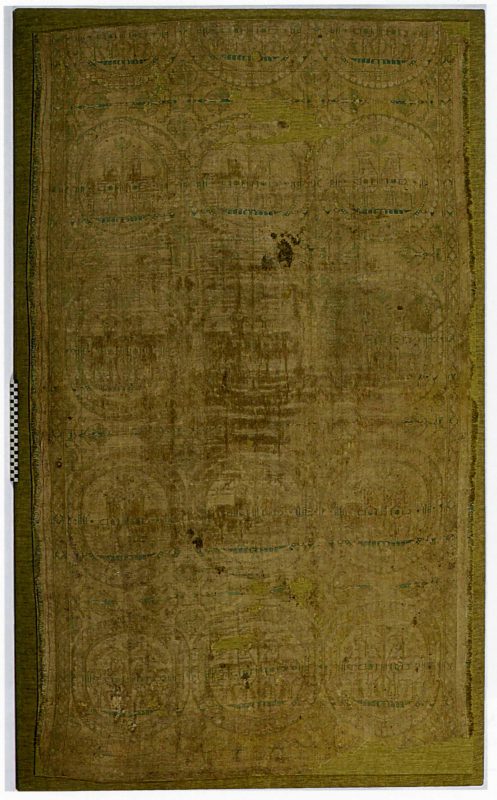
Fig. 14 Shroud of St. Mengold. Eastern provinces of the Abbassid Caliphate, 8th–9th century CE. Polychrome silk, L. 1.92 x W. 1.22 m. Collegiate Church of Notre-Dame, Huy, Belgium.
Image after Nicholas Sims-Williams and Geoffrey Khan, “Zandaniji Misidentified,” Bulletin of the Asia Institute n.s. 22 (2008 [2012]): plate 8.
Yet can we claim any direct influence of the Sogdian mural illustrations on the Arabic manuscript traditions that followed? One scholar suggests that the Sogdians may have had a practice of pictorial manuscripts alongside that of their mural paintings, and that such texts could have circulated westward into the Arab world. Alternatively, though, we may be seeing the impact of a shared tradition of earlier illustrations, spreading in multiple languages among multiple sites, from which both Sogdian and later Arabic traditions drew.
Finally, our journey west takes us to Europe and the question of the Central Asian silks in European cathedrals and churches, with which this article began; Fig. 14. Since the early twentieth century, scholars have made the case for these textiles as “Transoxanian”—that is, produced in an area between China and Iran. In 1923 Sir Aurel SteinMarc Aurel Stein Learn more about explorer and archaeologist Sir M. Aurel Stein, who had spent many years researching and excavating in different parts of Central Asia, expressly identified them as Sogdian, but it was only later in the century that this identification became more widespread.
In the 1950s came what seemed a major breakthrough—the discovery of a supposedly Sogdian inscription on the back of one such textile from the cathedral in Huy, Belgium; Fig. 15. The key word in the inscription was, according to the Sogdian linguistic expert W. B. Henning, “Zandaniji”—a term used by the 10th-century historian Narshakhi to describe textiles produced in Zandana , a site in Sogdiana close to Bukhara . Dorothy Shepherd, who discovered the inscription, was justifiably excited: “By great good fortune, unique in the annals of the history of textiles, an inscription with the name Zandaniji has come to light on a textile that, perhaps, may therefore be assigned to this famous center.”
Shepherd’s excitement was ill-founded, though, and set off a fifty-year wild goose chase as scholars applied the label “Zandaniji” to an ever-growing corpus of silks. The first issue with this identification was a recognition that medieval accounts of Zandana’s textiles referred to cottons, not silks. But the real problem was more startling. It turned out that the “Sogdian” writing on the back of the Huy textile was not Sogdian at all—it was Arabic! That Arabic makes no mention of Zandaniji; Fig. 16.
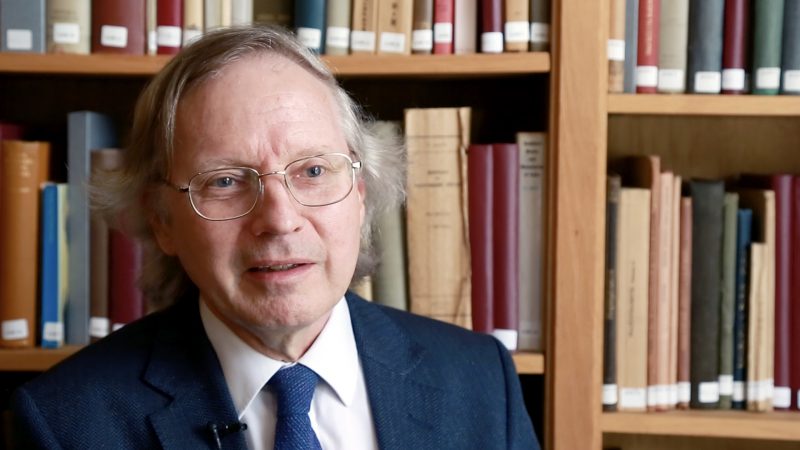
Fig. 16 Nicholas Sims-Williams (School of Oriental and African Studies) discusses the question of “Zandaniji” silks in Europe.
The mistaken identification of the Huy textile does not, however, rule out Sogdiana as the site of production of these Central Asian textiles in Europe. The fabrics were clearly produced in a region that could draw on West Asian technology and design conceptsSogdian Textiles along the Silk Road , as well as Chinese taste in colors and perhaps dye materials. The historical region of Sogdiana certainly fits the bill for this. But until further technical and stylistic research is carried out, the origin of these Central Asian silks must remain an unanswered question.
Representations of Sogdians in Foreign Art
All the textual and material evidence taken together makes a strong case for the physical presence of Sogdians, many doubtless lured by trade, in various locations far from Sogdiana. The evidence also suggests that goods produced by Sogdian craftsmen or traded by Sogdian merchants made their way over large areas of the Eurasian landmass. Our final type of evidence for Sogdians abroad is the representation of them in artworks found in various sites across Asia.
The presence of Sogdians in foreign locales does seem to have prompted local artists—especially in China—to depict Sogdian male types with a fascination that often verged on caricature. Many of the exotic characters depicted in Tang funerary figurines found in China are nowadays identified as Sogdians, on the basis of a variety of characteristics—physical traits such as aquiline noses, bushy beards, and corpulent figures; costumes, especially a tall, rather floppy hat; and accoutrements and activities. MusicRetracing the Sounds of Sogdiana Learn more about Sogdian Music and Musical Instruments in Central Asia and China and dance feature prominently in Chinese representations, with some figures playing a predecessor of the medieval lute, the pipa, and others gesticulating wildly as they perform a dance known as the “Sogdian Whirl;” Fig. 17. This dance was much appreciated in China, especially by the Chinese emperor Tang Xuanzong 唐玄宗 (r. 712–756).
Two problems arise, however. One is that, although these funerary figures are clearly exotic, none are expressly identified as Sogdian. Rather than intending them as specifically Sogdian, the Chinese artisans and public might have regarded them as generic “Western” figures. In categorizing them as Sogdian, we should rely more heavily on proof than presumption. The second issue is that the Sogdians in Sogdiana represented themselves in quite different fashion. In frescoes from Panjikent, for example, Sogdian banqueters are shown as tall, perhaps distortedly pale, with wasp waists and delicate facial features, and often beardlessBanqueting in Sogdiana Learn more about banqueting in Sogdiana—the complete opposite of the paunchy, rambunctious, Falstaffian characters we often characterize as Sogdians. Are we in danger of falling into a fallacy equal to the mistaken identification of Zandaniji textiles?
Fortunately, there is now firm evidence of how Sogdians had themselves depicted in pre-Tang and Tang China. Archaeologists in the last twenty years have uncovered, among many others, the sculpted tombs of two Sogdians in Xi’an —Shi Jun 史君 and An Qie 安伽, two prominent leaders, or sabao, of the Sogdian community in China. Let us compare the central figure in a scene on his couch, Fig. 18, with one of the chivalric banqueters from the fresco in Panjikent, Fig. 19. Both are portrayed enjoying a banquet, but the figure from Panjikent is slender, whereas An Qie has what we might term a “full figure.”
Yet An Qie was not uniquely corpulent, as a similar figure, in similar pose, occurs on an “anonymous” couch reportedly found in Anyang; Fig. 20. The stark difference in representation might be explained by a disparity in class and image. At Panjikent the figures may be seated, but they wear their swords proudly, and clearly belong to a class of knights whose chivalric prowess in hunt and battle was illustrated in several other frescoes from Panjikent and Afrasiab (now in Iran).
Fig. 20 Detail from the back panel of Funerary Couch: Banqueting Scene. China, Northern Qi dynasty (550–577 CE). Marble; entire back panel H. 64 × W. 115.8 × D. 10 cm. Museum of Fine Arts, Boston, 12.588. View object page
Photograph © Museum of Fine Arts, Boston.
The Sogdian sabao, on the other hand, were leaders of merchant communities, for whom an ample girth was a sign of worldly success. Some of the feasting in the scenes on the couches may have had a ritual or postritual association, but drink, food, music, and dance were evidently expressions of joie de vivre among these expatriate Sogdians. In a community that brought fancies and fashions from the West to the Tang capital, these reflected a broader cultural trait among the Sogdians. As the earliest classic history of the Tang, the Tang Shu 唐書, succinctly states, “The people [of Samarkand] are addicted to wine, and like to sing and dance in the streets.”
There could be no more detailed and expressive portrayal of portly, bearded figures intoxicated by wild dance, music making, and drink than the three scenes on a massive silver and silver-gilt jug, Fig. 21, from the most important monastery in Tibet. This is Lhasa’s Jokhang Monastery, established by the founder of the Tibetan empire, Songtsen Gampo (569/605–649?). In two scenes on the jug, a figure cavorts while playing a pipa behind his head. In the third he has bulkily collapsed, comatose, his head limp, into the arms of two hapless comrades; Figs. 22–24. Scholars have rather acrimoniously debated whether this jug was made in Tibet by Tibetan silversmiths or by Sogdians in Tibet, or even by Sogdians in Sogdiana. What does not appear to be in dispute is that the musicians are meant to be Sogdian. The jug’s spout takes the form of a camel’s head, likely a reference to the Silk Road. The depiction of the dancing musician is so lively and full of incidental detail that it transcends the generic, and may well be meant as a portrait of a historical figure. The jug was presumably for wine, with its images a visual paraphrase of the drink’s intoxicating effects. Associated with Songtsen Gampo, it reflects his interest in imbibing, which was sufficient to earn him two references in the Tang Shu: one to his commissioning a golden goose that could hold ten gallons of wine, the other to his request in 649 CE to the Chinese emperor Gaozong to send him wine presses.
A historical embodiment of this Sogdian penchant for abandon was the Tang-dynasty general An Lushan, who, according to Edwin Pulleyblank, was born of a Sogdian father ( the surname An referred to BukharaThe Nine Sogdian Surnames Learn more about the Chinese names for Sogdian families in China) and a Turkic mother. An Lushan’s rebellion almost toppled the Tang regime, but fact, fiction, and fantasy have combined to create a legend of a man. In Pulleyblank’s words, he was “an enormously fat man with a talent for buffoonery” and who became a favorite of the notorious imperial concubine Yang Guifei. After receiving a gift of “Western twirling girls” from several Sogdian cities including Samarkand, Emperor Xuanzong so delighted in the Sogdian Whirl dance that both Yang Guifei and An Lushan learned to perform it. With An Lushan, facts turn into a swirl of often ribald legends. Was he—a man said to weigh at least 400 pounds—really “adopted” by Yang Guifei in a spoof ceremony that involved his being dressed in an oversized diaper? It does not matter, for legends can be even more formative than facts.
The image of the Sogdian in China went from the exotic and the entertaining to grotesque caricature and the essence of moral corruption at the heart of the Tang court. The Tang figurines of an ensemble of Sogdian musicians lurching on top of a camel were synecdochic of the Silk Road caravans that brought not only riches from the West but an aura of abandon; Fig. 25. The bronze statuette from Gansu of a Sogdian dancer was a pasquinade—hatted, high-stepping, hook-nosed; Fig. 26. It is this caricatural image of the Sogdian that was to reach the eastern edge of the Old World, Japan.
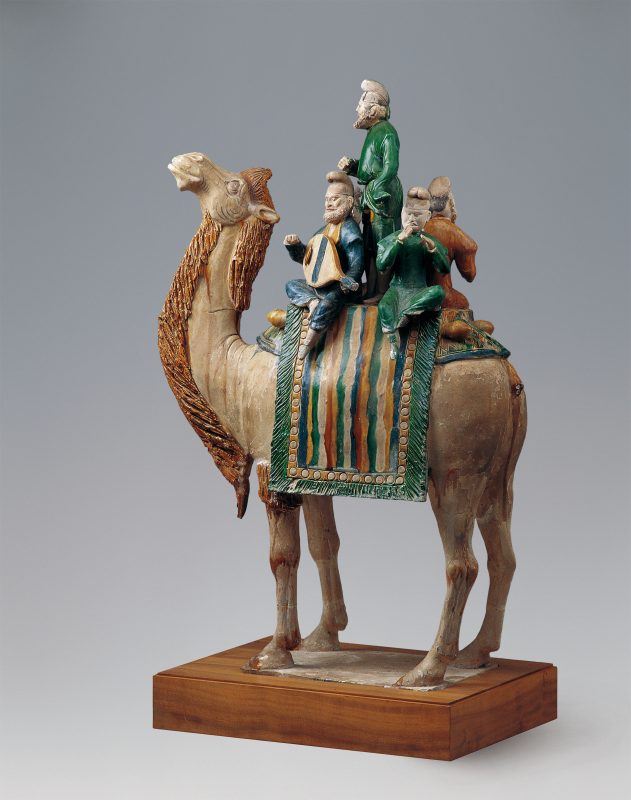
Fig. 25 China, Tang dynasty (618–907 CE) Glazed earthenware, H. 58.4 cm Excavated in 1957 from tomb, dated to 723 CE, of Xianyu Tinghui, general of Yunhui, in western suburbs of Chang’an (Xi’an) National Museum of China, Beijing View object page
Photograph © National Museum of China.
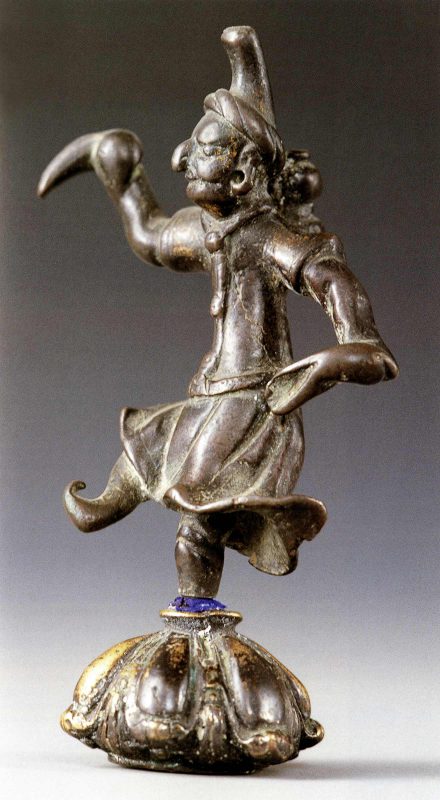
Fig. 26 Dancing Central Asian. From vicinity of Shandan, Gansu province, China, 7th century CE. Partly gilt bronze; H. 13.7 × W. 8 cm. Shandan Municipal Museum, China. View object page
Image after Annette L. Juliano and Judith A. Lerner, Monks and Merchants, (New York: Harry N. Abrams with the Asia Society, 2001), 255, cat. 82.

Fig. 27 Japanese Gigaku mask of “Intoxicated Barbarian King” (Suiko-ō). Japan, 8th century. Carved Paulownia wood, with white undercoating, polychrome pigments, gold leaf, and ink drawing; adhered horse hair; 37.0 × 22.6 × 29.4 cm. Shōsō-in, Nara. Treasure No. 47. View object page
Photograph © Shosoin Repository.
The wooden masks that survive in the 8th-century Nara treasuries of the Shōsōin Repository and the Hōryūji temple were once accoutrements of the Gigaku 伎樂 musical theater popular at the imperial court, and were used to portray the bearded “drunken barbarian king”; Fig. 27. This was not a figure precisely definable in time and place, but a stock comic character that embodied the visual parody of the Gansu dancer and the verbal pointedness found in the Tang Shu. The Sogdian abroad has—at the eastern edge of the Old World—become a representation divorced from reality, mediated through Chinese visual and verbal sources.
Conclusion
So how do we make sense of the geographic scope and reach of the Sogdians abroad? This article has explored three dimensions of the Sogdians abroad—their physical journeys, the journeys of their material culture, and the journeys of their images in the arts of foreign cultures. It has shown how tricky it can be to pin the Sogdians down. Outside of the heartlands of Central Asia and China, we must rely on scattered references and glimpses of Sogdians in far-flung places. However, considering their status as peddlers and craftsmen, it is no surprise that firm textual and material evidence should be so scanty. On balance, such evidence does confirm the journeys of Sogdian traders and goods over large distances, from Southeast Asia even as far (on at least one occasion) as Byzantium. The representations of Sogdians in varied artistic traditions offer a different kind of testimony to the Sogdian abroad. While at times suggesting the physical presence of Sogdians in the places where the artwork was found, such depictions also suggest their cultural influence in the creation of a stock figure—the “man from the West”—that clearly was well known to multiple Asian cultures. Key elements of the Sogdians’ cultural identity—particularly their felt hats, fulsome beards, and love of wine and dancing—traveled long distances, as we can most clearly see in the mask of the drunken king in Japan. But whether this mask is merely a relic of a half-understood, imagined “Other” or testament to the physical presence of Sogdians at the farthest edges of the Silk Road remains—like so much about the Sogdians abroad—tantalizingly beyond our reach.
The greater part of these treasures were donated to the Imperial Household in 1878, and are now in the Tokyo National Museum.
The fabric was used to wrap the relics of Saint Amon of Toul, a city twenty-five kilometers to the west of Nancy. See Dorothy G. Shepherd, “Zandaniji Revisited,” In Documenta Textilia: Festschrift für Sigrid Müller-Christensen, ed. Machtild Flury-Lemberg and Karen Stolleis (Munich: Deutscher Kunstverlag, 1981), 105–22.
For the quoted phrase on Sogdians’ monopoly and on their trade in India, see Nicholas Sims-Williams, trans., “The Sogdian Merchants in China and India,” in Cina e Iran da Alessandro Magno alla dinastia Tang, ed. A. Cadonna and L. Lanciotti, vol. 5 of Orientalia Venetiana (Florence: Casa Editrice Leo S. Olschki, 1996), esp. 49–51. For the monk in Vietnam, see Frantz Grenet, “Les marchands sogdiens dans les Mers du Sud à l’époque préislamique,” in Cahiers d’Asie centrale 1, no. 2 (1996): 66.
For the quote from Ya‘qubi, see Étienne de la Vaissière, Sogdian Traders: A History, trans. James Ward. (Leiden and Boston: Brill, 2005), 303. For Sogdian metalwork and Tibet, see Amy Heller,“The silver jug of a Lhasa Jokhang: Some observations on silver objects and costumes from the Tibetan empire (7th–9th century),” Silk Road Art and Archaeology, vol. 9 (2003): 213–37. Also see the forum that followed the article, which you can access at http://www.asianart.com/phpforum/subforum.php?sfid=1.
Frantz Grenet, “Crise et sortie de crise en Bactriane-Sogdiane aux IVe–Ve s. de n. è.: De l’héritage antique à l’adoption de modèles sassanides,” in La Persia e l’Asia Centrale da Alessandro al X secolo: Atti dei Convegni Lince 127 (Rome: Accademia Nazionale dei Lincei, 1996), 367–90.
This person, known as Kang Seng-Hui, is analyzed in Étienne de la Vaissière, Sogdian Traders: A History, trans. James Ward (Leiden and Boston: Brill, 2005), 71–74.
For trade between Sogdiana and the steppe, see Sören Stark, “Luxurious Necessities: Some Observations on Foreign Commodities and Nomadic Polities in 6th to 9th Century Central Asia,” in Complexity of Interaction along the Eurasian Steppe Zone in the First Millennium AD, ed. Jan Bemmann and Michael Schmauder, Bonn Contributions to Asian Archaeology 7 (Bonn: Vor- und Frühgeschichtliche Archäologie Rheinische Friedrich-Wilhelms-Universität Bonn, 2015), 463–502. For slave trading and Samarkand, see Étienne de la Vaissière, Sogdian Traders: A History, trans. James Ward (Leiden and Boston: Brill, 2005), 301–6.
S.G. Klyashtornyĭ, Drevnetyurskie runicheskie pamyatniki kak istochnik po istorii Sredney Azii Древнетюркские рунические памятники как источник по истории Средней АзииM/span> [Runic inscriptions in ancient Turkic as sources for the history of Central Asia] (Moscow 1964), 78–101.
For Sogdians in Mongolia, see Étienne de la Vaissière, “Sogdian Trade,” in Encyclopædia Iranica (EIr), available online at http://www.iranicaonline.org/articles/sogdian-trade, n.d. For the silver statuette, see Markus Mode, “Sogdiana VI: Sogdian Art.” In Encyclopædia Iranica, n.d. available online at http://www.iranicaonline.org/articles/sogdiana-vi-sogdian-art.
Étienne de la Vaissière, Sogdian Traders: A History, trans. James Ward (Leiden and Boston: Brill, 2005), 228–32.
Elfriede R. Knauer, “A Man’s Caftan and Leggings from the North Caucasus of the Eighth to Tenth Century: A Genealogical Study,” Metropolitan Museum Journal 36 (2001): 125–54.
Étienne de la Vaissière, Sogdian Traders: A History, trans. James Ward (Leiden and Boston: Brill, 2005), 284–85.
For the account of Afshin Haydar, see Tabari, Annales quos scripsit Abu Djafar Mohammed ibn Djarir at-Tabari, ed. M. J. de Goeje (Leiden: E. J. Brill, 1881), Vol. III/2, 1309 and 1318, under the events for the year 226/841; and Emel Esin, “The Turk Al-Agam of Samarra and the Paintings Attributable to Them in the Gawsaq Al-Haqani,” Kunst des Orients 9 (1973 [1974]): 47–88. See also Guitty Azarpay, Sogdian Painting: The Pictorial Epic in Oriental Art (Berkeley, Los Angeles, and London: University of California Press, 1981), 13, 202–3, fig. 59. For Manichaean illustrated manuscripts, see A. von Le Coq, Die buddhistische Spätantike in Mittelasien,II. Die manichäischen Miniaturen (Berlin: Dietrich Reimer Verlag, 1923; reprint, Graz: Akademie Druck, 1973); and Along the Ancient Silk Routes: Central Asian Art from the West Berlin State Museums, exh. cat., Metropolitan Museum of Art (New York, 1982). For the potential influence on Arabic manuscript production, see Guitty Azarpay, Sogdian Painting: The Pictorial Epic in Oriental Art (Berkeley: University of California Press, 1981), 178–79; and Julian Raby, “Between Sogdia and the Mamluks: A Note on the Earliest Illustrations to Kalila wa Dimna,” Oriental Art 33, no. 4 (Winter, 1987–88): 381–98.
For the identification of the silks as Transoxanian, see Otto von Falke and Julius Lessing, Kunstgeschichte der Seidenweberei (Berlin: Wasmuth, 1913). See also Mark Aurel Stein, Serindia: Detailed report of explorations in Central Asia and westernmost China, vol. 2 of 5 vols. (London and Oxford: Clarendon Press, 1921), 907–9, 939, 1049–50.
Dorothy G. Shepherd and W. B. Henning, “Zandaniji Identified?” in Aus der Welt der islamischen Kunst: Festschrift für Ernst Kühnel (Berlin: Gebr. Mann, 1959), 15–40.
Nicholas Sims-Williams and Geoffrey Khan, “Zandanījī Misidentified,” Bulletin of the Asia Institute 22 (2008 [2012]): 207–13. For an account of the whole story, see Zvezdana Dode, “‘Zandanījī Silks’: The Story of a Myth,” The Silk Road 14 (2016): 213–22. http://www.silkroadfoundation.org/newsletter/vol14/Dode_SR14_2016_213_222.pdf.
For the couch from Anyang, see Boris I. Marshak [Marschak/Maršak], “La thématique sogdienne dans l’art de la Chine de la seconde moitié du VIe siècle,” Comptes rendus des séances de l’Académie des Inscriptions et Belles-Lettres 145, no. 1 (2001): 227–64. For the frescoes from Panjikent, see Boris I. Marshak and Valentina I. Raspopova, “A Hunting Scene from Panjikent,” Bulletin of the Asia Institute, n.s. 4 (1990): 77–94. The passage from the Tang Shu is quoted in Edward H. Schafer, The Golden Peaches of Samarkand: A Study of T’ang Exotics (Berkeley, CA: University of California Press, 1985), 153.
See Amy Heller, “The silver jug of a Lhasa Jokhang: Some observations on silver objects and costumes from the Tibetan empire (7th–9th century),” Silk Road Art and Archaeology 9 (2003): 213–37. Also see the forum that followed the article, records of which you can access at http://www.asianart.com/phpforum/subforum.php?sfid=1.
For An Lushan, see Edwin G. Pulleyblank, “An Lu-Shan,” in Encyclopædia Iranica (EIr), 2011, also available at http://www.iranicaonline.org/articles/an-lu-shan-frontier-general. For the general’s learning of the Sogdian dance, see Edward H. Schafer, The Golden Peaches of Samarkand: A Study of T’ang Exotics (Berkeley, Los Angeles, London: University of California Press, 1985), 56.
